
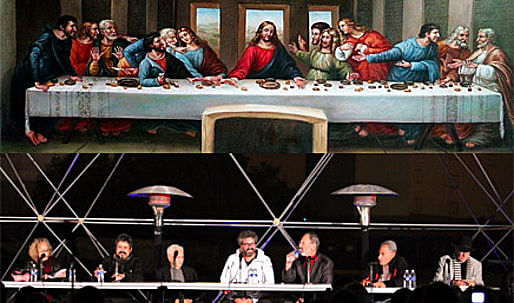
It was a SCI-ARC night. LAPD helicopters thumping overhead, spotlights sweeping down. The twinkle of downtown just beyond. Derelict shopping carts and garbage just outside the fence. I parked between a shipping container and sheets of plywood near the shop. As I looked in, I could see some students pulling their hair out over the CNC machine. “Architecture and Beauty: A Troubled Relationship”, catalyzed by Yael Reisner’s new book (and the fact that these architects were all in town), was off to a good start even before I sat down.
By Guy Horton
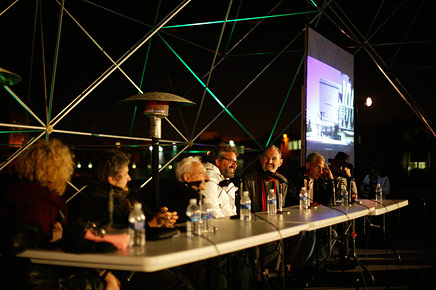
Here, in the parking lot, enveloped within the giant LED-illumined space-frame of the Graduation Pavilion, on plastic folding chairs, behind plastic tables, one therapist tried to get six patients to talk about their inner worlds. This was one of the most interesting aspects of the evening: watching six architects wrestle with the nature of beauty as mediated through their work, positioning themselves in the profession, within culture, and as people.
Ms. Reisner’s introduction neatly framed the problematic as the struggle between utilitarian tendencies and emotional creative drives. This analysis came across as suspiciously linear and selective. It tended to universalize and partition off what could be classed as anti-aesthetic functionalism while allowing a democratic, subjective aesthetic realm to thrive in opposition. This overlooks the multiple streams and aesthetic impulses of what later became historicized as “modernism.” Despite this epistemological problem a few good points come through: one is that while aesthetics are intrinsic to architecture, it is problematized because of outside cultural, historical, or political forces. The “depth-scape”, as she calls it, is compromised as it is translated from the personal to the social arena of appearance.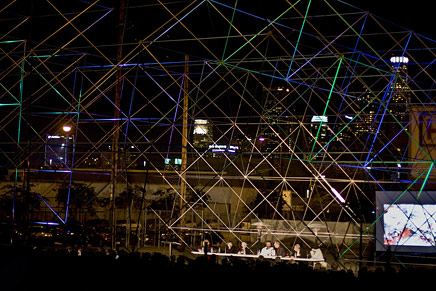
Panels like this seem more fitting for the presentation of papers or positions rather than free-wheeling discussions that jump back and forth. For this reason it was not always easy to get a read on what the participants actually thought about aesthetics or what might determine the terms of beauty. The repeating slideshow of their work may have spoken more to their understandings. Some were more revealing than others. Reisner’s book, however, presents a more complete picture of how they view themselves and their aesthetics—or at least instances of this are frozen in time.
Rather than a blow-by-blow recounting (you can view the evening from the SCI-ARC archives), here are brief fragments that try to capture what each architect said. It follows the order of their “last supper” positioning from left to right.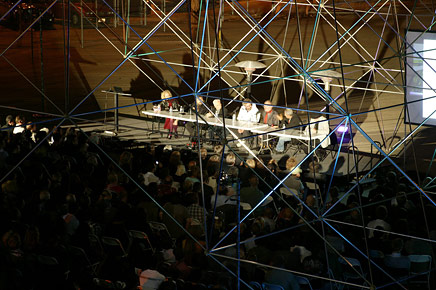
Hernan Diaz Alonso: Clenching an unlit cigar. Bad readings, misinterpretations of science, philosophy and other disciplines can be a place from which something starts. There exists in architecture an insecurity that enables it to look to other things. This is not necessarily a bad thing. Afterwards, I will present some of the more colorful exchanges that took place.
Frank Gehry: We respond to our times. Architecture doesn’t have much meaning anymore. The type of work we do is on the margins. There are different reasons for doing things. Self-expression is not necessarily the most important thing in architecture. Let people do what they want. Allow multiple points of view to coexist and don’t talk down to people or impose your will on them. Critics can be a force for good because you can learn things from them. We are small pieces of the puzzle.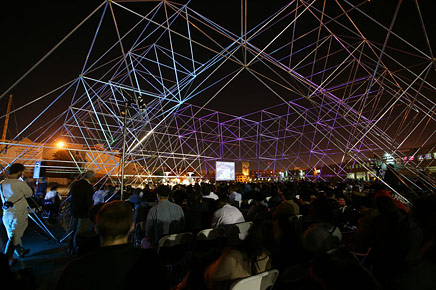
Greg Lynn: It’s important to be contradictory and challenge global and accepted norms. Find your own position with the software rather than let the software’s signature determine your position.
Thom Mayne: Looking up at helicopters every time they drown out the speakers. What we are really talking about is the shift in operational strategies and processes that came about in the 80’s and 90’s. The “I” is not static. Architects like us frighten people, don’t you think?
Eric Owen Moss: Critical distance is important. Outsiders provide important perspectives. Lewis Mumford, John Dreyfuss, Herbert Muschamp all had productive things to say.
Peter Cook: What we are really talking about is bull shit, but good bull shit. What Reisner is doing is pushing us out of our comfort zones. You have to watch out for those creepy guys (critics) because they can have a direct impact on how you are perceived and affect your business.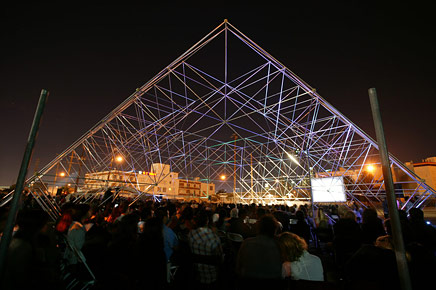
There were some tense moments that produced some oo’s and ah’s from the audience. Laughter would erupt when certain architects who were not present were mentioned. Frank Gehry didn’t laugh at anyone—he was too thoughtful.
In one exchange Reisner, in response Greg Lynn asking why she didn’t include architects like David Chipperfield and Richard Meier, stated they weren’t included because they represented mere continuations of the modernist movement. To this, members of the audience booed and hissed. Ms. Reisner seemed shocked that they didn’t agree.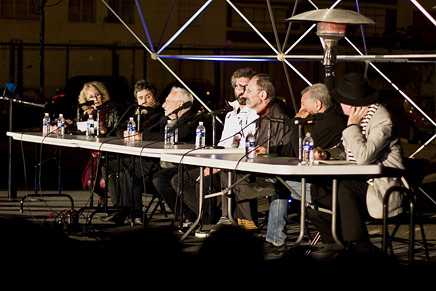
Gerhy, with sage-like coolness, jumped to Mr. Chipperfield’s defense by saying that he had “figured out a way to exist.” Chipperfield, not present to defend himself, was thus invoked as an example of someone who had successfully negotiated the complexities and difficulties of the profession to carve out an identity. No easy task.
There was another moment when Ms. Reisner declared Greg Lynn to be a “digital” architect. In response, Mr. Moss said he didn’t think Lynn was a digital architect at all and that he couldn’t be determined by such labels. This is what Peter Cook was talking about when he called critics “those creepy guys.” There was irony this. After all, Ms. Reisner, who is also an architect, is Cook's wife and I somehow doubt he finds her creepy. This reminds me of a line from a movie in which one character says, “You think I’m an asshole but I’m really just British.”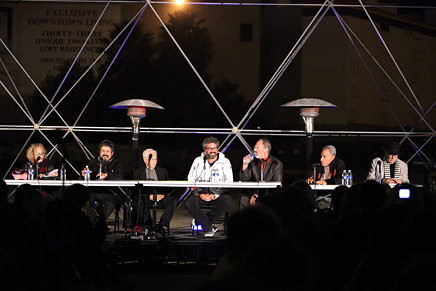
When Ms. Reisner repeated something Lynn had said in the interview for the book. Mr. Lynn empathically stated, “I never said that!” At least he didn’t think that is what he had said, but that was how it was interpreted. This is often what happens in the process of translation. The interviews in the book were conducted by Ms. Reisner, but the actually narratives in the book were written by a journalist by the name of Fleur Watson. Mind the gap.
The point here is that what these architects say about themselves and their work can have different meanings and their ideas can change over time. Their work can change too, a theme Gehry, Mayne and Moss repeated. They didn’t seem to recognize transformations in Lynn’s work, but what comprises change for one architect might be different for another. Plus, Lynn can respond—or not respond if he so chooses—to different sorts of pressures that someone like Moss may not react to.
When it was time for questions a queue formed behind a microphone. A gentleman, who identified himself as “one of the creepy guys”, made a brief speech about something. Greg Lynn voiced everyone’s desire to leave by saying, “We’re done, right?” I made my way to the buffet table but it was swarming with starving SCI-ARC students.
Arriving at my car, I looked into the shop. The same students I had observed struggling with the CNC were still there, scratching their heads. The machine seemed to be not producing the results they had desired. How do you make your inner world a reality and what happens when you do?
Guy Horton, based in Los Angeles, is a frequent contributor to Architectural Record and other publications. He is also the author of the weekly column, The Indicator, featured on Arch Daily.
Creative Commons License
This work is licensed under a Creative Commons License .
/Creative Commons License
Guy Horton is a Los Angeles writer and author of the critical blog, The Indicator on ArchDaily.com, which covers issues ranging from the culture, politics, and business of architecture to theory and aesthetics. He is a frequent contributor to The Architect's Newspaper, The Atlantic Cities ...
16 Comments
I like write ups like this; lots of quips and anecdotes. Having gone to the panel, reading this was more enjoyable than sitting in the cold and listening to these guys carefully tread water. For what could have been a very good and heated discussion, the panel was made up of mostly co-horts, friendlies, and people who don't want to politically piss each other off. Nobody really disagreed, or at least didn't publicly.
Should have been a different group on stage.
I thought Yael's whole dis-inclusion of people like Chipperfield and Pawson, simply because in her mind they are 'Modernists' (and according to her Modernism is bad) pretty telling. That and then she throws both Hernan and Greg on there........
Surprised you didn't mention anything vis the Schumacher lecture, which was really the only thing they all got worked up about.
I agree, this makes great reading. I am happier to read your translation of the event than listed to the real thing. Not to be too demanding, but how about some more text?
what i see is a fraudulent table. this is the exact culture architecture needs to get rid of. all these people clinging onto their silk underwear, discussing irrelevant stuff to stay somewhat in the public eye. this conversation is long over.
yack!
i would hardly liken this bunch to the gathering of the real Last Supper, for there is no Judas or Jesus among them.
west coast occult. did they trade urine samples or bite each other?
off with their heads! all of them!
peter cook is the only interesting one of the lot and that's just for ideas and his general character- not architecture. maybe eric moss if you like listening to some interesting sophist talking. the rest are a bunch of jokers- except maybe thom mayne, who's a nice guy but whose buildings just plain suck. and has any of them combined made even one good piece of architecture? meanwhile, in japanese, the word for diarrhea is "geri" (same as gehry, which is quite appropriate).
maybe try again...and try much harder.
I'm not normally very sensitive to these things, nor am I the least bit religious, but I find the comparison of this group to Jesus Christ's Last Supper, however satirical, to be offensive. You may think they're smart, ground-breaking, even sexy, geniuses, but they also presided over one of the most arrogant and misguided times in the history of architecture, and look where the profession is now. I would have loved to see that they spoke about something that actually mattered... alas.
what, they talked about themselves didn't they? Isn't that what matters?
i love the narcissism of these events myself.
also don't mind that they didn't talk about "important" things. not every dinner conversation needs to be brilliant and sometimes just talking is enough. Even if it is self-indulgent, it is still critical and thoughtful (or sounds like it was based on the summary). so why not?
as far as i can tell in the end it will be what these guys produce that makes the difference, not what they say. this is just a bit of sloppy gravy added to the parametric fries. and gravy is supposed to be fat filled and bad for all involved...;-)
the christ and the disciples thing i don't get.
nice piece.
have any of these architects done anything of note in the last five years?
more and more, i get the impression that [greg lynn/peter cook/eric owen moss/diaz alonso/etc.] are a bunch of washed-up, out-of-touch academics.
Wow. Angry words. I find the antisemitism voiced against Yael Reisner incredibly ugly.
You have a right to dislike anything you want, but dismissing these architects is stupid. They each have contributed a great deal to architecture, and provide interesting and varying opinions about a narrow (but not insignificant) part of our profession. I have agreed with some of these speakers positions and disagreed with others, but reading or listening to their opinions has always been stimulating.
Lynn has produced great pieces of text, Gehry has been a transformative force in architecture, Cook has influenced countless students and academics, and Mayne has been willing to stand up to those in power who want easy (and often reactionary) solutions.
Isn't there a more intelligent way to offer alternatives to the group without resorting to childish attacks?
Thanks Sarah, well put. There is a reactionary tea-party-itis timbre to many of these comments. An equal and opposite reaction to the progressive and experimental? The return of "beauty" in the discourse is not "west coast occult", it is all over the map, perhaps because no one is building anymore we go back to the most elusive of subjects.
these guys are all outstanding architects. i wouldn't dismiss any of them at all, but for the time being the profession of architecture appears to be moving away from what most of them appear to stand for, which are formal expression, material experimentation and/or esoteric intellectualism. i'm painting with a broad brush here and am not against what they may stand for or how that fits into what is happening to the profession.
however, i think some of the more vulgar reactions to this stem from the state of an economy which especially is encouraging an attitude toward design that points more toward functionalism, quality construction, entrepreneurialism, and value, none of which are mutually exclusive to great architecture.
looks like an amazing conversation, but having not been there both the discourse and even the very setting do come off as completely out of touch with the times, unless the image of the last supper itself was somehow an implication of the relevance of this discourse to the next decade. to their defense, i wasn't there, but to me the real underlying relevance of this conversation is how to make a thing of beauty in this decade with what we now have to work with. maybe that is what they meant to do all along.
to elaborate more on my second paragraph, i meant to say that the more vulgar reactions stem from people's frustration in this economy, and that in order to succeed in design and business people need to adopt the mentioned principles of functionalism et.al., which this panel does not represent.
sorry i now realize it's not greatly worded.
we're just advocating new leadership in our profession - these guys (for the most part) represent an outdated era.
clear some space for new ideas, values and leaders - those that are making an impact both inside and outside our profession. Kieran Timberlake, BIG, adjaye, chipperfield (and many others) are the architects that are actively shaping in the future of architecture, not these guys.
Sectionalhealing
I do agree with you that there might be a need for a bigger space for new voices in architecture but your list (KT, BIG, Adjaye, Chipp) seems to be very arbitrary and a list of your personal favorites, not people with real influence or effect in the field. How can you deny that Gehry transformed the way the building industry operates? How can you not see that Lynn's design methods really became the norm now for using the computer as a design tool? People here are being completely reactionary because of the big egos at the table, but at the end of the day these people have real influence whether you have personal or aesthetic disagreements with them or not. I completely agree that the conservative tone against experimentation and labeling it as irresponsible is really problematic and damaging to our community. there really is no figure or direction in this so called new era in architecture- what the hell are you guys talking about? There's all this wishy washy talk that goes on about this new structure, new era, new blah blah, where is it? Who is it made by? what are the examples of it????
Block this user
Are you sure you want to block this user and hide all related comments throughout the site?
Archinect
This is your first comment on Archinect. Your comment will be visible once approved.